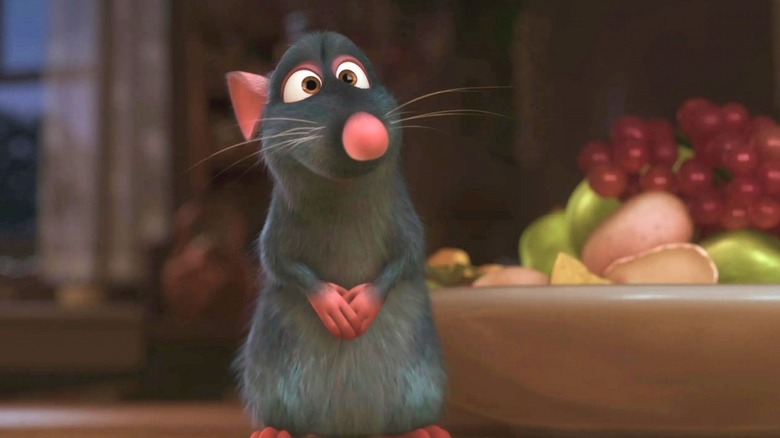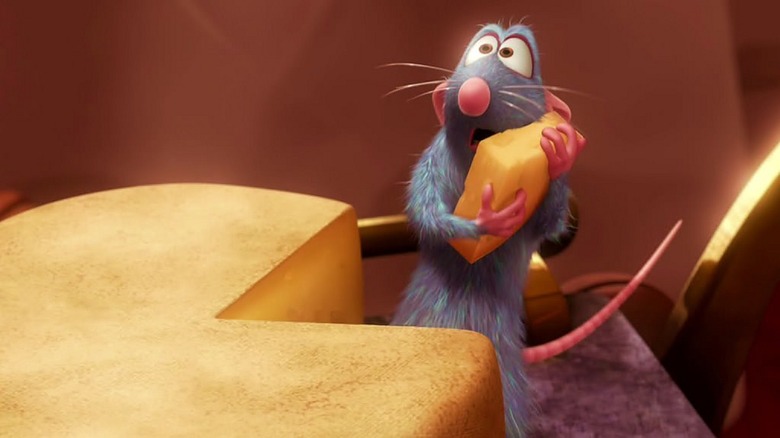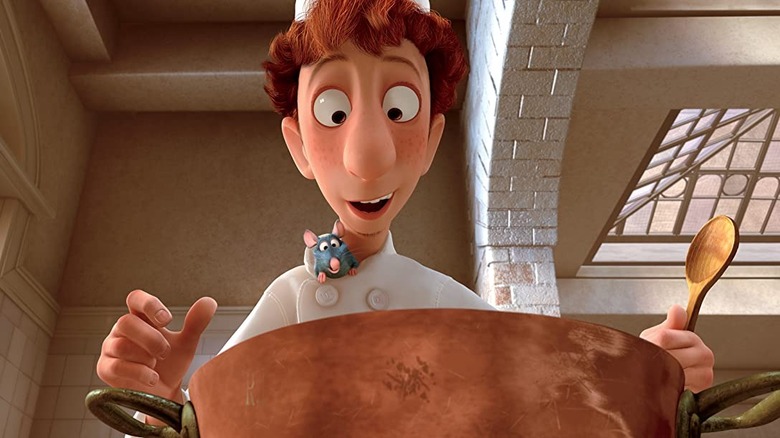Disney Did Some Unusual Research To Recreate Ratatouille's Kitchen
Animation is a meticulous process, and attention to detail marks the difference between a good animated film and a great one. As large-budget animated features have continued to advance technologically, so too have animators' ability to add in a great deal more visual nuance. In high-profile productions like the ones Pixar regularly produces, entire teams of designers and animators are devoted to conceptualizing and creating all the tiny details in the background of each shot. In animation, every single prop that a character picks up or physically interacts with needs to be designed and animated, and the animation will only be that much richer if those little props have as much authenticity as possible.
In the 2007 film "Ratatouille" — a film about a rat gourmand who dreams of working as a chef in a human restaurant — the kitchen equipment was designed to look as real as possible. Every single spoon and every single pot has a sense of authenticity. The pots alone required considerations like their style, age, what kind of wear they had accrued in their history, what kinds of dents and stains they might have, and what sort of materials they were made of (and how heavy those materials are, as to accurately animate a human character lifting them).
"Ratatouille" is a masterwork of attention to detail. Set largely in the kitchen of a swanky, slightly fallen French restaurant called Gusteau's, "Ratatouille" builds an environment from the group up, filling the kitchen with not only pots and pans, but every single tool used by a hardworking French chef. In order to maintain a sense of believability, the movie's production team had to know how certain ingredients are prepared, what kind of tools might be found at certain stations, the different kinds of chefs ... they essentially needed to give themselves a crash course in the classic French restaurant industry. And while there likely wasn't time and money to send every single Pixar animator to Le Cordon Bleu, they were able to give themselves an education in a hurry by observing a night of action at Chef Thomas Keller's restaurant The French Laundry, located in Yountville, California.
The French Laundry
Located in an old laundry building — hence the name — The French Laundry was opened as a restaurant by Mayor Don Schmitt in 1978, then was bought by Chef Thomas Keller in 1994. Keller and his team of chefs transformed The French Laundry into one of the most prestigious restaurants in the world, eventually earning it three Michelin stars and an induction into the Culinary Hall of Fame. If you pay attention to political scandal, you may recall that The French Laundry was where California governor Gavin Newsom was photographed attending a party. I have heard good things about their silk tuna tartare.
As revealed in a "Ratatouille" behind-the-scenes featurette, "Behind the Swinging Door," supervising animator Dylan Brown (who also acted as supervising animator on Pixar films "A Bug's Life," "Toy Story 2," "Monsters Inc.," "Finding Nemo," and "The Incredibles") was permitted into the kitchen of The French Laundry for an entire evening in order to get a better sense of the kind of atmosphere he would want to animate. In the video, Brown states that his idea of the way a professional kitchen actually operated was completely different from his conception. He was astonished that spoons — and almost no other tools — were the primary mechanism for measuring and plating food.
The chefs
Once the kitchen had been constructed, "Ratatouille's" character animators took over, creating a cast of colorful characters to fill it. Vibing with actual professional kitchens, the animators understood the kind of motley crews that tend to occupy their high-pressure atmosphere. The film's story director Jan Pinkava observed in "Behind the Swinging Door" that it is a blue-collar job performed by tough people, a notable contrast between the gentle atmosphere, deep red hues, and hushed sensual pleasures of the restaurant's dining space. They have scars and burns from working with sharp knives and hot stoves all day. As well, each of the chefs in "Ratatouille" has a backstory, a talent, a personality — even if they only appear on screen for a few moments. Chefs can, and do, come from just about any background, and the animators on "Ratatouille" wanted to reflect that.
A talented animation team, given the proper time, can fill any background space with rich, amazing detail, and make incidental characters burst with life and personality after only a brief moment of introduction. In "Ratatouille," every second of screen time is packed with interesting details that add authenticity to the movie's world. The kitchen looks useable and lovely, and feels like a nice place to work — and an amazing place to eat.
Personally, I will start saving up my money to have dinner at The French Laundry.


